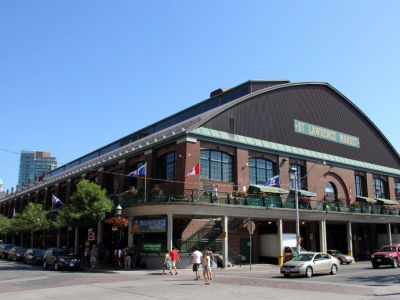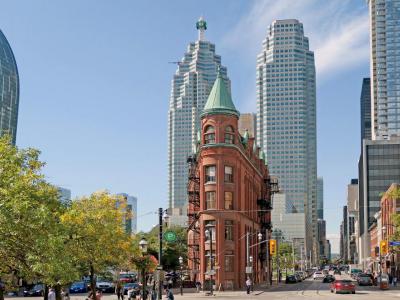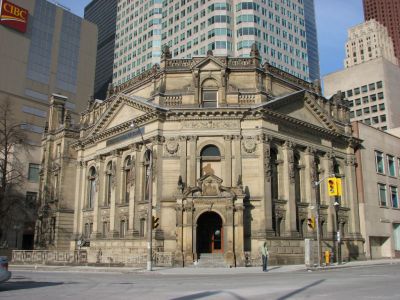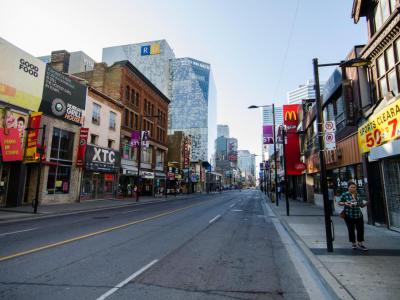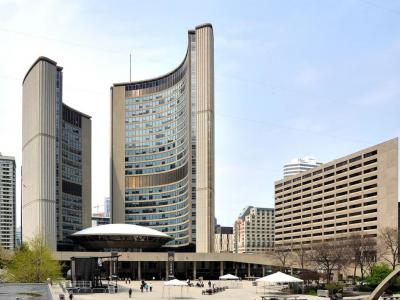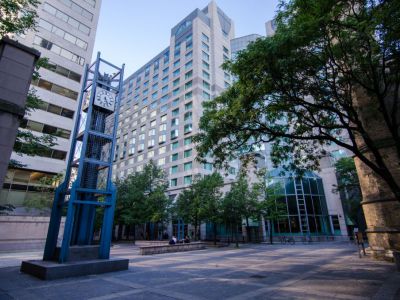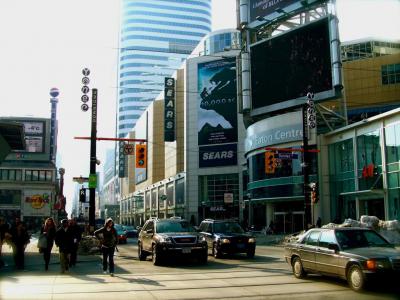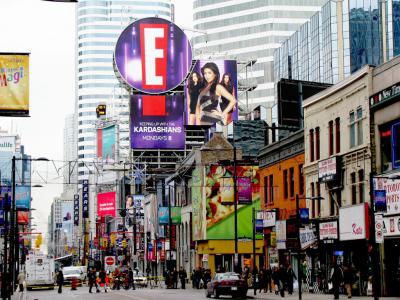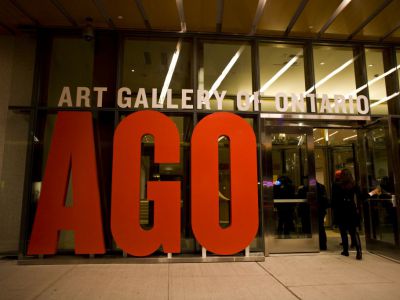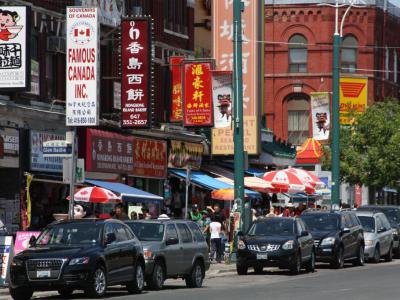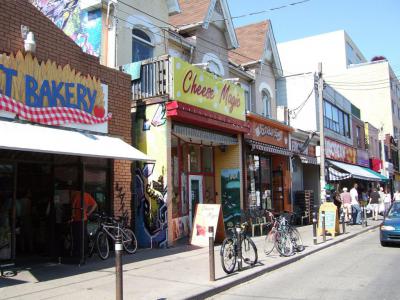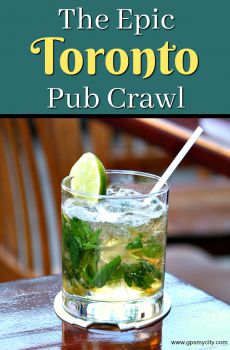
Toronto Introduction Walking Tour (Self Guided), Toronto
Sprawling on the northwestern shore of Lake Ontario, the capital of the Canadian province of Ontario, Toronto, is a major metropolis renowned for its dynamic pace and high-rising skyline, incorporating both ultra-modern skyscrapers and historic architecture.
The area of present-day Toronto has been inhabited for thousands of years. Its first known settlers – the Wyandot (or Huron) people – had occupied the region long before the 1500s, followed later by the Iroquois tribe. The name Toronto is likely derived from the Iroquoian word “tkaronto”, which means the place where trees stand in water. Another theory suggests that Toronto means "plenty" and was adopted by the French in the 1630s as part of their lexicon originating from the Huron and Iroquoian languages.
Following the so-called Toronto Purchase of 1787, the British took over the territory and established here a town called York. In 1834, the town was incorporated as a city and subsequently renamed Toronto. Thirty-three years later, the city became the capital of the Ontario province within the Canadian Confederation.
Around the same time, a thriving industrial area developed around Toronto Harbour and the lower Don River mouth, linked by rail and water to the rest of Canada and the United States. Traces of that period include the Gooderham Distillery, once the world's largest whisky manufacturer, which is now part of the historic "Distillery District".
Waves of immigration in the 19th and 20th centuries saw the arrival in Toronto of European settlers (Irish, German, French, Italian, Russian, Polish, and Jewish), as well as Chinese. Such ethnic diversity is presently reflected in local neighbourhoods, such as Chinatown, Kensington Market, and others.
The post-WWII boom resulted in a rapid expansion of Toronto, largely contributing to its cultural and urban development, resulting in a wealth of entertainment and recreational facilities. Shopping areas like St. Lawrence Market and Toronto Eaton Centre are recognized as the city's most popular attractions, drawing annually millions of visitors.
Torontonians take their sport seriously, especially when it comes to their much-loved ice hockey. No visit to the city is complete without getting a glimpse of this fascinating game – best done at the Hockey Hall of Fame!
Traveling on foot is advantageous in Toronto, as it comes to life with its blend of quirky sights, sounds, and unique architecture. For a more detailed acquaintance with the historical and modern capital of Ontario and a chance to explore some of its prominent landmarks, embark on this self-guided introductory walk.
The area of present-day Toronto has been inhabited for thousands of years. Its first known settlers – the Wyandot (or Huron) people – had occupied the region long before the 1500s, followed later by the Iroquois tribe. The name Toronto is likely derived from the Iroquoian word “tkaronto”, which means the place where trees stand in water. Another theory suggests that Toronto means "plenty" and was adopted by the French in the 1630s as part of their lexicon originating from the Huron and Iroquoian languages.
Following the so-called Toronto Purchase of 1787, the British took over the territory and established here a town called York. In 1834, the town was incorporated as a city and subsequently renamed Toronto. Thirty-three years later, the city became the capital of the Ontario province within the Canadian Confederation.
Around the same time, a thriving industrial area developed around Toronto Harbour and the lower Don River mouth, linked by rail and water to the rest of Canada and the United States. Traces of that period include the Gooderham Distillery, once the world's largest whisky manufacturer, which is now part of the historic "Distillery District".
Waves of immigration in the 19th and 20th centuries saw the arrival in Toronto of European settlers (Irish, German, French, Italian, Russian, Polish, and Jewish), as well as Chinese. Such ethnic diversity is presently reflected in local neighbourhoods, such as Chinatown, Kensington Market, and others.
The post-WWII boom resulted in a rapid expansion of Toronto, largely contributing to its cultural and urban development, resulting in a wealth of entertainment and recreational facilities. Shopping areas like St. Lawrence Market and Toronto Eaton Centre are recognized as the city's most popular attractions, drawing annually millions of visitors.
Torontonians take their sport seriously, especially when it comes to their much-loved ice hockey. No visit to the city is complete without getting a glimpse of this fascinating game – best done at the Hockey Hall of Fame!
Traveling on foot is advantageous in Toronto, as it comes to life with its blend of quirky sights, sounds, and unique architecture. For a more detailed acquaintance with the historical and modern capital of Ontario and a chance to explore some of its prominent landmarks, embark on this self-guided introductory walk.
How it works: Download the app "GPSmyCity: Walks in 1K+ Cities" from Apple App Store or Google Play Store to your mobile phone or tablet. The app turns your mobile device into a personal tour guide and its built-in GPS navigation functions guide you from one tour stop to next. The app works offline, so no data plan is needed when traveling abroad.
Toronto Introduction Walking Tour Map
Guide Name: Toronto Introduction Walking Tour
Guide Location: Canada » Toronto (See other walking tours in Toronto)
Guide Type: Self-guided Walking Tour (Sightseeing)
# of Attractions: 12
Tour Duration: 2 Hour(s)
Travel Distance: 4.1 Km or 2.5 Miles
Author: alice
Sight(s) Featured in This Guide:
Guide Location: Canada » Toronto (See other walking tours in Toronto)
Guide Type: Self-guided Walking Tour (Sightseeing)
# of Attractions: 12
Tour Duration: 2 Hour(s)
Travel Distance: 4.1 Km or 2.5 Miles
Author: alice
Sight(s) Featured in This Guide:
- St. Lawrence Market
- Gooderham Building
- Hockey Hall of Fame
- Yonge Street
- Old City Hall
- Toronto New City Hall
- Trinity Square
- Eaton Centre
- Yonge-Dundas Square
- Art Gallery of Ontario (AGO)
- Chinatown
- Kensington Market
1) St. Lawrence Market (must see)
Established in 1803, Saint Lawrence Market is the nerve centre of Toronto's commercial activity. Located in the former industrial area (between Jarvis, Front, King, and Church streets), this is the city's largest and perhaps most famous market. The bulk of its crowd are locals doing regular grocery shopping or simply popping in for a cup of coffee or chit-chat with neighbors. Tourists are also seen here rather often, lured by the bustling atmosphere and tasty foods.
Undoubtedly, food is the main draw at Saint Lawrence. Here, you can find everything: from beef to kangaroo meat, plus hundreds of kinds of cheeses, gourmet dog treats, local wines, French baked goods, Greek olive oil, and even New Zealand honey. There is also plenty of prepared food, such as the famous peameal bacon sandwich, that you can eat right on site.
The South Market section houses daily sales of fresh produce, dairy, and meats. Freshly-baked goods are also available here all day, much as some non-food items. There is a number of artisan shops selling jewelry and other crafts. Also, the Market Gallery, on the second floor, has an area for cultural events.
The North Market section traditionally houses a Saturday farmer’s market (featuring producers from southern Ontario) and a Sunday antiques sale. Both ventures start at 5 o'clock in the morning and run until 5 o'clock in the evening.
From an architectural standpoint, Saint Lawrence is just as attractive. Its massive main brick building, with a cast-iron ceiling inspired by London’s Saint Pancras train station, was constructed in 1902. Part of the Old City Hall, which dates from 1845, was incorporated into the building, and you can still see part of the original jail on the lower level of the market.
Undoubtedly, food is the main draw at Saint Lawrence. Here, you can find everything: from beef to kangaroo meat, plus hundreds of kinds of cheeses, gourmet dog treats, local wines, French baked goods, Greek olive oil, and even New Zealand honey. There is also plenty of prepared food, such as the famous peameal bacon sandwich, that you can eat right on site.
The South Market section houses daily sales of fresh produce, dairy, and meats. Freshly-baked goods are also available here all day, much as some non-food items. There is a number of artisan shops selling jewelry and other crafts. Also, the Market Gallery, on the second floor, has an area for cultural events.
The North Market section traditionally houses a Saturday farmer’s market (featuring producers from southern Ontario) and a Sunday antiques sale. Both ventures start at 5 o'clock in the morning and run until 5 o'clock in the evening.
From an architectural standpoint, Saint Lawrence is just as attractive. Its massive main brick building, with a cast-iron ceiling inspired by London’s Saint Pancras train station, was constructed in 1902. Part of the Old City Hall, which dates from 1845, was incorporated into the building, and you can still see part of the original jail on the lower level of the market.
2) Gooderham Building
Among the many places worth visiting in the Saint Lawrence neighborhood, especially for an architecture buff, is the Gooderham Building. Hardly five stories tall, wedged in a triangular intersection between Front and Wellington streets, this structure is one of the most photographed sights in the city. The house was built in 1892, ten years before its famous kin, the Fuller Building in New York City, and as such, represents an early example of the flatiron form of architecture.
The previous building on this site was shorter but of the same shape and was called the Coffin Block. The current vermilion red-brick edifice, with tinges of Romanesque styling, was constructed for distiller George Gooderham and served as the office of the Gooderham & Worts distillery until 1952. The Gooderham family sold the property in 1957, following which it changed hands several times. In 1975, the building was designated a historic site under the Ontario Heritage Act.
Besides its shape, the Gooderham Building is well-known for the mural on its back wall. The Flatiron Mural – created by renowned Canadian artist Derek Michael Besant – uses a trompe-l'œil effect to make the wall appear to have more windows than it does, as well as to give it a more mobile effect with the help of a picture of the Perkins Building, which is located directly across the street, depicted as if loosely 'tacked' down to the wall, with some of its edges 'fluttering' away.
Right behind the Gooderham Building is a tree-lined spot called Berczy Park. This park, housing a sizeable three-tier fountain fitted with 27 cast-iron dogs spouting water, a cast-iron cat, and crowned with a bone, was completed in 2017. The drinking trough for dogs has made this fountain a popular destination, particularly for dog lovers.
The previous building on this site was shorter but of the same shape and was called the Coffin Block. The current vermilion red-brick edifice, with tinges of Romanesque styling, was constructed for distiller George Gooderham and served as the office of the Gooderham & Worts distillery until 1952. The Gooderham family sold the property in 1957, following which it changed hands several times. In 1975, the building was designated a historic site under the Ontario Heritage Act.
Besides its shape, the Gooderham Building is well-known for the mural on its back wall. The Flatiron Mural – created by renowned Canadian artist Derek Michael Besant – uses a trompe-l'œil effect to make the wall appear to have more windows than it does, as well as to give it a more mobile effect with the help of a picture of the Perkins Building, which is located directly across the street, depicted as if loosely 'tacked' down to the wall, with some of its edges 'fluttering' away.
Right behind the Gooderham Building is a tree-lined spot called Berczy Park. This park, housing a sizeable three-tier fountain fitted with 27 cast-iron dogs spouting water, a cast-iron cat, and crowned with a bone, was completed in 2017. The drinking trough for dogs has made this fountain a popular destination, particularly for dog lovers.
3) Hockey Hall of Fame (must see)
Situated in Toronto, the Hockey Hall of Fame serves as a museum dedicated to preserving the rich history of ice hockey. Its establishment in 1943 owes much to the unwavering dedication of James Thomas Sutherland, a revered figure in the sport, known affectionately as the "Father of Hockey."
Encompassing an expansive area spanning 57,000 square feet, this venue is thoughtfully divided into 15 distinct sections. Each section showcases the remarkable achievements and honors earned by both NHL teams and international counterparts, along with the celebrated players who graced the ice. Within these exhibits, visitors can marvel at prestigious cups, trophies, cherished memorabilia, as well as the iconic equipment and jerseys worn by renowned hockey personalities.
The inclusion of interactive displays adds an element of excitement, allowing visitors to test their skills by facing real pucks as goaltenders—a particular favorite among children. Additionally, the on-site shop offers an excellent selection of team apparel for enthusiastic fans.
The Hockey Hall of Fame finds its home in a former Bank of Montreal office building, a captivating attraction in its own right. Once Canada's largest bank branch, this architectural masterpiece dates back to 1885 and showcases the exquisite Beaux-Arts style. Its facades are adorned with ornate stonework, a testament to an era when projecting an image of prosperity and security was paramount. Renowned as one of the city's most remarkable bank structures ever constructed, it exudes a sense of opulence and grandeur.
Tip:
For a few extra bucks, you can get a photo taken with the Stanley Cup – three printed copies and one digital.
Encompassing an expansive area spanning 57,000 square feet, this venue is thoughtfully divided into 15 distinct sections. Each section showcases the remarkable achievements and honors earned by both NHL teams and international counterparts, along with the celebrated players who graced the ice. Within these exhibits, visitors can marvel at prestigious cups, trophies, cherished memorabilia, as well as the iconic equipment and jerseys worn by renowned hockey personalities.
The inclusion of interactive displays adds an element of excitement, allowing visitors to test their skills by facing real pucks as goaltenders—a particular favorite among children. Additionally, the on-site shop offers an excellent selection of team apparel for enthusiastic fans.
The Hockey Hall of Fame finds its home in a former Bank of Montreal office building, a captivating attraction in its own right. Once Canada's largest bank branch, this architectural masterpiece dates back to 1885 and showcases the exquisite Beaux-Arts style. Its facades are adorned with ornate stonework, a testament to an era when projecting an image of prosperity and security was paramount. Renowned as one of the city's most remarkable bank structures ever constructed, it exudes a sense of opulence and grandeur.
Tip:
For a few extra bucks, you can get a photo taken with the Stanley Cup – three printed copies and one digital.
4) Yonge Street
Yonge Street, a prominent thoroughfare in Toronto, is renowned for its vibrant shopping and entertainment district. It is home to iconic landmarks such as the Eaton Center, Yonge-Dundas Square, and the Hockey Hall of Fame. Stretching across the city, Yonge Street serves as a vital commercial artery and a key route connecting the shores of Lake Ontario to Lake Simcoe, providing access to the Upper Great Lakes.
With its origins dating back to the 1790s, Yonge Street played a crucial role in the planning and settlement of western Upper Canada. Recognized as an Event of National Historic Significance, its construction holds significant historical value for the country. The street was named in honor of Sir George Yonge, an esteemed authority on ancient Roman roads and a close friend of John Graves Simcoe, Ontario's first colonial administrator.
As the heart of the city, Yonge Street is a vibrant hub that hosts parades, street performances, and occasional protests. Following major sporting triumphs, it has become a cherished tradition for thousands of people to gather along the downtown stretches, particularly near Dundas Square, to revel in celebration. During these joyous occasions, Yonge Street is closed to vehicular traffic, and streetcar operations are often halted a short distance east or west of the street to accommodate the bustling crowds.
With its origins dating back to the 1790s, Yonge Street played a crucial role in the planning and settlement of western Upper Canada. Recognized as an Event of National Historic Significance, its construction holds significant historical value for the country. The street was named in honor of Sir George Yonge, an esteemed authority on ancient Roman roads and a close friend of John Graves Simcoe, Ontario's first colonial administrator.
As the heart of the city, Yonge Street is a vibrant hub that hosts parades, street performances, and occasional protests. Following major sporting triumphs, it has become a cherished tradition for thousands of people to gather along the downtown stretches, particularly near Dundas Square, to revel in celebration. During these joyous occasions, Yonge Street is closed to vehicular traffic, and streetcar operations are often halted a short distance east or west of the street to accommodate the bustling crowds.
5) Old City Hall
Located at the intersection of Queen and Bay Streets in Downtown Toronto stands an impressive building with Romanesque-style architecture. This remarkable structure, known today as the Old City Hall, served as the Toronto City Council's home from 1899 to 1966, becoming the third city hall constructed for the flourishing city. Upon its completion, it ranked among the largest buildings in Toronto and stood as the largest civic edifice in North America.
Renowned architect Edward James Lennox led the creation of this masterpiece. Over a decade of construction, the majestic City Hall emerged as an iconic landmark. Its remarkable clock tower, standing at 103.6 meters (340 feet), became the city's crown jewel. The clock mechanism was crafted in Croydon, England. Inside the clock room, three bells were placed: two smaller ones that chimed every quarter hour, and a bourdon bell weighing 5,443 kilograms, which tolled every hour.
Matching the splendid exterior, the interior of the building exuded charm, adorned with intricate details. Noteworthy features include a grand staircase adorned with stained glass windows depicting Canadian history, various murals, statues, and other decorative elements.
Despite its grandeur, the Old City Hall proved inadequate for Toronto's expanding municipal government within a few decades of its construction. In the 1960s, plans were made to demolish the building and make way for a retail complex known as the Eaton Centre. However, thanks to public outcry, the Old City Hall was saved and repurposed as a courthouse. In 1984, it received the prestigious designation as a National Historic Site, preserving its historical significance for future generations.
Tip:
Make sure to visit the small "lake" close by, as many of the pictures from Toronto you might know are taken from this place while facing the "TORONTO" sign.
Renowned architect Edward James Lennox led the creation of this masterpiece. Over a decade of construction, the majestic City Hall emerged as an iconic landmark. Its remarkable clock tower, standing at 103.6 meters (340 feet), became the city's crown jewel. The clock mechanism was crafted in Croydon, England. Inside the clock room, three bells were placed: two smaller ones that chimed every quarter hour, and a bourdon bell weighing 5,443 kilograms, which tolled every hour.
Matching the splendid exterior, the interior of the building exuded charm, adorned with intricate details. Noteworthy features include a grand staircase adorned with stained glass windows depicting Canadian history, various murals, statues, and other decorative elements.
Despite its grandeur, the Old City Hall proved inadequate for Toronto's expanding municipal government within a few decades of its construction. In the 1960s, plans were made to demolish the building and make way for a retail complex known as the Eaton Centre. However, thanks to public outcry, the Old City Hall was saved and repurposed as a courthouse. In 1984, it received the prestigious designation as a National Historic Site, preserving its historical significance for future generations.
Tip:
Make sure to visit the small "lake" close by, as many of the pictures from Toronto you might know are taken from this place while facing the "TORONTO" sign.
6) Toronto New City Hall
Ontario's capital boasts yet another architectural marvel known as the New City Hall, captivating the lenses of countless photographers. This iconic emblem of Toronto stands as a remarkable testament to the city's individuality and elegance.
The visionary behind the New City Hall was Finnish architect Viljo Revell, chosen for the task through an international competition that attracted an astounding 500 designs from 42 countries. Initially, the competition faced severe criticism and controversy, with some insisting that a Canadian should have been entrusted with the project. Nevertheless, the outcome bestowed upon Toronto one of its most splendid edifices, beloved by all and regarded as a symbol of the region.
The construction of the New City Hall commenced in 1961 and spanned four years. The building has a rectangular base with curved towers of different heights. The east tower is 27 stories (99.5 meters) tall, while the west tower is 20 stories (79.4 meters) tall. The towers cradle a saucer-like council chamber. Concrete covers the curved surfaces with a rib pattern for strength and to prevent fabric collapse due to exterior expansion or tearing caused by different air pressures. The north, west, and east sides have abstract and sculptural designs, while the south side facing the square has extensive glazing.
From the air, the building resembles an unblinking eye, earning it the nickname "The Eye of Government." Its futuristic design stirred controversy, but it was praised as an exceptional city hall by Arthur in his book, Toronto, No Mean City.
The visionary behind the New City Hall was Finnish architect Viljo Revell, chosen for the task through an international competition that attracted an astounding 500 designs from 42 countries. Initially, the competition faced severe criticism and controversy, with some insisting that a Canadian should have been entrusted with the project. Nevertheless, the outcome bestowed upon Toronto one of its most splendid edifices, beloved by all and regarded as a symbol of the region.
The construction of the New City Hall commenced in 1961 and spanned four years. The building has a rectangular base with curved towers of different heights. The east tower is 27 stories (99.5 meters) tall, while the west tower is 20 stories (79.4 meters) tall. The towers cradle a saucer-like council chamber. Concrete covers the curved surfaces with a rib pattern for strength and to prevent fabric collapse due to exterior expansion or tearing caused by different air pressures. The north, west, and east sides have abstract and sculptural designs, while the south side facing the square has extensive glazing.
From the air, the building resembles an unblinking eye, earning it the nickname "The Eye of Government." Its futuristic design stirred controversy, but it was praised as an exceptional city hall by Arthur in his book, Toronto, No Mean City.
7) Trinity Square
Nestled amidst prominent landmarks like the Eaton Center to the east, Bell Trinity Square to the south and west, and the Marriott Downtown Eaton Center Hotel to the north, lies Trinity Square, a cherished location in Toronto.
In the 19th century, this area was known as the Terauley Estate, where Terauley Cottage stood. The property was owned by John Simcoe Macaulay, who sold it in 1845 to pave the way for the construction of the Church of the Holy Trinity. This Anglican church still dominates the square today. Additionally, the square is home to the Holy Trinity Rectory and Henry Scadding House, both of which are esteemed heritage buildings.
Notable features within the square include a fountain with an ornamental pond, where water cascades from a tall wall, an artificial stream running alongside the pathway to Bay Street, and a labyrinth path.
The three grand columns at the square's entrance lead to the Toronto Public Labyrinth, which aligns with water-based labyrinths. The granite blocks used for paving and the nearby water feature remind of the buried Taddle Creek. The labyrinth is oriented towards the true north, indicated by directional lines formed by the granite blocks. Adjacent to the church is a clock tower similar to the Bay Street columns.
In the 1970s, Trinity Square faced the threat of demolition due to plans for the massive Toronto Eaton Centre. However, determined protests from Toronto citizens led to a redesign of the mall, ensuring the preservation of the square, the church, and the nearby Old City Hall.
In the 19th century, this area was known as the Terauley Estate, where Terauley Cottage stood. The property was owned by John Simcoe Macaulay, who sold it in 1845 to pave the way for the construction of the Church of the Holy Trinity. This Anglican church still dominates the square today. Additionally, the square is home to the Holy Trinity Rectory and Henry Scadding House, both of which are esteemed heritage buildings.
Notable features within the square include a fountain with an ornamental pond, where water cascades from a tall wall, an artificial stream running alongside the pathway to Bay Street, and a labyrinth path.
The three grand columns at the square's entrance lead to the Toronto Public Labyrinth, which aligns with water-based labyrinths. The granite blocks used for paving and the nearby water feature remind of the buried Taddle Creek. The labyrinth is oriented towards the true north, indicated by directional lines formed by the granite blocks. Adjacent to the church is a clock tower similar to the Bay Street columns.
In the 1970s, Trinity Square faced the threat of demolition due to plans for the massive Toronto Eaton Centre. However, determined protests from Toronto citizens led to a redesign of the mall, ensuring the preservation of the square, the church, and the nearby Old City Hall.
8) Eaton Centre (must see)
Toronto caters to any visitor's idea of the "best shopping day ever" as its shopping destinations are perfectly compatible with all budgets, however diverse. Still, no shopping experience in Toronto is complete without visiting the Eaton Centre.
Quite literally "shop-till-you-drop", this Downtown location – anchored between Queen, Dundas, and Yonge streets – is the largest shopping mall in Eastern Canada. The colossal – 160,000 square meters – shopping complex contains more than 230 retail outlets, restaurants, and services under one roof and has definitely something for everyone.
The place is named for Timothy Eaton, owner of a dry goods store on Yonge Street, who in the 19th century revolutionized retailing in Canada. By the 20th century, Eaton's chain of department stores was the largest in the country and owned most of the land in the neighbourhood.
In the mid-1960s, the chain announced plans to build a massive shopping mall that would occupy several city blocks. This implied the demolition of the Old City Hall and the Church of the Holy Trinity. Although the plans were eventually revised, to make way for the new complex, several streets ultimately disappeared from the city street grid.
The Eaton Centre's first phase opened in 1977, featuring ultra-modern, for that time, exterior design as a token of dominance and aspirations. Originally marketed as "Eaton Centre", the complex was renamed "Toronto Eaton Centre" in the early 1990s to disambiguate from other Eaton Centres spawned across Canada.
Today, apart from the high-end boutiques and exclusive stores, inside this premier shopping venue you will find popular universal brands and even bargain marts. With a massive visitor count of over one million a year, the Toronto Eaton Centre has become a regular entry on every tourist’s list.
Quite literally "shop-till-you-drop", this Downtown location – anchored between Queen, Dundas, and Yonge streets – is the largest shopping mall in Eastern Canada. The colossal – 160,000 square meters – shopping complex contains more than 230 retail outlets, restaurants, and services under one roof and has definitely something for everyone.
The place is named for Timothy Eaton, owner of a dry goods store on Yonge Street, who in the 19th century revolutionized retailing in Canada. By the 20th century, Eaton's chain of department stores was the largest in the country and owned most of the land in the neighbourhood.
In the mid-1960s, the chain announced plans to build a massive shopping mall that would occupy several city blocks. This implied the demolition of the Old City Hall and the Church of the Holy Trinity. Although the plans were eventually revised, to make way for the new complex, several streets ultimately disappeared from the city street grid.
The Eaton Centre's first phase opened in 1977, featuring ultra-modern, for that time, exterior design as a token of dominance and aspirations. Originally marketed as "Eaton Centre", the complex was renamed "Toronto Eaton Centre" in the early 1990s to disambiguate from other Eaton Centres spawned across Canada.
Today, apart from the high-end boutiques and exclusive stores, inside this premier shopping venue you will find popular universal brands and even bargain marts. With a massive visitor count of over one million a year, the Toronto Eaton Centre has become a regular entry on every tourist’s list.
9) Yonge-Dundas Square (must see)
Yonge-Dundas Square is an unparalleled destination that embodies the essence of Toronto. It was conceived in 1997 as part of an initiative to revitalize the bustling intersection of Yonge and Dundas streets Downtown. Although not a traditional square, this vibrant space forms an irregular pentagon, encompassed by Dundas Street East to the north, Victoria Street to the east, Yonge Street to the west, and Dundas Square to the south.
Designed with careful intention, this so-called square features a gentle incline that enhances its theatrical ambiance. Since its completion in 2002, Yonge-Dundas Square has become the beating heart of Toronto's cultural scene, serving as a focal point within the Yonge entertainment and shopping district, and radiating with perpetual liveliness.
Illuminated by colossal billboard screens and adorned with corporate logos, the square often draws comparisons to the iconic Times Square in New York City, the vibrant Shibuya district in Tokyo, and the renowned Piccadilly Circus in London. To manage the tremendous influx of pedestrians, surpassing an astounding 100,000 per day, a pedestrian scramble was introduced in 2008, making it the first of its kind in the city.
Encompassing the square, one can find notable landmarks such as the Toronto Eaton Centre, Ed Mirvish Theatre, and the Citytv building. The centerpiece of Yonge-Dundas Square is an enchanting array of fountains: two rows of ten fountains gracefully dispersed along the main walkway, inviting visitors to pass through or around them.
This public square serves as a unifying space, bringing together individuals from all walks of life. It stands as a prominent emblem of Toronto, regularly hosting public events, celebrations, performances, and captivating art displays.
Designed with careful intention, this so-called square features a gentle incline that enhances its theatrical ambiance. Since its completion in 2002, Yonge-Dundas Square has become the beating heart of Toronto's cultural scene, serving as a focal point within the Yonge entertainment and shopping district, and radiating with perpetual liveliness.
Illuminated by colossal billboard screens and adorned with corporate logos, the square often draws comparisons to the iconic Times Square in New York City, the vibrant Shibuya district in Tokyo, and the renowned Piccadilly Circus in London. To manage the tremendous influx of pedestrians, surpassing an astounding 100,000 per day, a pedestrian scramble was introduced in 2008, making it the first of its kind in the city.
Encompassing the square, one can find notable landmarks such as the Toronto Eaton Centre, Ed Mirvish Theatre, and the Citytv building. The centerpiece of Yonge-Dundas Square is an enchanting array of fountains: two rows of ten fountains gracefully dispersed along the main walkway, inviting visitors to pass through or around them.
This public square serves as a unifying space, bringing together individuals from all walks of life. It stands as a prominent emblem of Toronto, regularly hosting public events, celebrations, performances, and captivating art displays.
10) Art Gallery of Ontario (AGO) (must see)
Toronto boasts an impressive architectural marvel known as the Art Gallery of Ontario (AGO), which houses the largest collection of Canadian art in the world. Spanning a vast 45,000 square meters (480,000 square feet), this museum complex ranks among North America's largest art venues.
Originally established in 1900 as the Art Museum of Toronto by a group of private citizens and members of the Toronto Society of Arts, it later acquired its first home, the historic Georgian manor known as The Grange, in 1911. In 1966, the institution adopted its present name, the Art Gallery of Ontario. Throughout its history, the museum has undergone several expansions to its north and west, with the most recent ones occurring in the early 2000s and 2010s.
AGO's permanent collection boasts an impressive total of over 120,000 items. These exhibits showcase various artistic movements and eras, organized into distinct "collection areas" dedicated to specific art forms, artists, benefactors, chronological periods, or geographic locales. On the second floor, visitors can explore an extensive collection of Canadian art, including works by First Nations and Inuit artists.
Additionally, throughout the museum's halls, over 80,000 European art pieces dating from 1000 CE to 1900 CE are on display. Noteworthy European artworks include those by renowned artists such as Gian Lorenzo Bernini, Edgar Degas, Thomas Gainsborough, Paul Gauguin, Claude Monet, Rembrandt, Auguste Rodin, and James Tissot. Paintings and sculptures adorn the ground floor, while the museum's concourse features a captivating collection of mostly British ship models.
Enthusiasts of modern and contemporary art will also find satisfaction in the works of Andy Warhol, Claes Oldenburg, and Jenny Holzer. The gallery's remarkable collection of modern sculptures, including the groundbreaking creations of Henry Moore, is equally awe-inspiring with its semi-abstract designs.
The AGO's architecture alone is a sight to behold, but combined with the wealth of artwork contained within, it guarantees an immensely enjoyable experience. Before leaving, visitors can also browse the museum's shop and discover an array of fun and intriguing items on offer.
Tip:
The museum policy allows for exiting and re-entering on your ticket within the day.
Originally established in 1900 as the Art Museum of Toronto by a group of private citizens and members of the Toronto Society of Arts, it later acquired its first home, the historic Georgian manor known as The Grange, in 1911. In 1966, the institution adopted its present name, the Art Gallery of Ontario. Throughout its history, the museum has undergone several expansions to its north and west, with the most recent ones occurring in the early 2000s and 2010s.
AGO's permanent collection boasts an impressive total of over 120,000 items. These exhibits showcase various artistic movements and eras, organized into distinct "collection areas" dedicated to specific art forms, artists, benefactors, chronological periods, or geographic locales. On the second floor, visitors can explore an extensive collection of Canadian art, including works by First Nations and Inuit artists.
Additionally, throughout the museum's halls, over 80,000 European art pieces dating from 1000 CE to 1900 CE are on display. Noteworthy European artworks include those by renowned artists such as Gian Lorenzo Bernini, Edgar Degas, Thomas Gainsborough, Paul Gauguin, Claude Monet, Rembrandt, Auguste Rodin, and James Tissot. Paintings and sculptures adorn the ground floor, while the museum's concourse features a captivating collection of mostly British ship models.
Enthusiasts of modern and contemporary art will also find satisfaction in the works of Andy Warhol, Claes Oldenburg, and Jenny Holzer. The gallery's remarkable collection of modern sculptures, including the groundbreaking creations of Henry Moore, is equally awe-inspiring with its semi-abstract designs.
The AGO's architecture alone is a sight to behold, but combined with the wealth of artwork contained within, it guarantees an immensely enjoyable experience. Before leaving, visitors can also browse the museum's shop and discover an array of fun and intriguing items on offer.
Tip:
The museum policy allows for exiting and re-entering on your ticket within the day.
11) Chinatown (must see)
Toronto's Chinatown, also referred to as Downtown Chinatown or West Chinatown, stands as one of the largest enclaves of Chinese culture in North America. Situated at the crossroads of Spadina Avenue and Dundas Street West, this neighborhood emerged from a modest Chinese community in the 1950s-1960s, nestled within what was primarily a Jewish district at the time.
Initially, the area was predominantly inhabited by individuals from southern China and Hong Kong. However, following Hong Kong's transfer to the People's Republic of China in the late 1990s, there has been a significant influx of migrants from mainland China. In recent years, Chinatown has adapted to changing demographics and gentrification, largely influenced by the growing interest of urban professionals and young individuals working in the Financial District.
While several renowned restaurants and barbecue shops on Dundas Street West have closed as a result, the majority of grocery stores have endured. Notable Chinese malls like Dragon City and Chinatown Centre continue to thrive. Alongside these Chinese establishments, visitors will also discover a diverse array of shops and restaurants representing other East Asian cultures, including Vietnamese, Thai, and Japanese.
Nevertheless, amidst these transformations, a few longstanding establishments have withstood the test of time since before the neighborhood acquired its Chinatown status. One such example is the El Mocambo live music venue, which opened its doors in the 1940s. Other enduring attractions include vibrant open-air markets and shops along Spadina Avenue, where one can find fresh fruits, vegetables, herbal medicine, and souvenirs.
Chinese New Year festivities, featuring live stage performances, martial arts demonstrations, and lion dances, constitute yet another local highlight that captivates both tourists and residents alike. The abundance of Chinese signage grants this enchanting neighborhood a captivating atmosphere, particularly during a leisurely stroll.
Furthermore, its appeal is heightened, especially late at night, by the wide range of affordable eateries offering diverse menus, spanning from dim sum to pho to modern fusion. For those seeking unique gifts to bring home, Chinatown offers a broad selection at more affordable prices compared to the city center and other locales.
Initially, the area was predominantly inhabited by individuals from southern China and Hong Kong. However, following Hong Kong's transfer to the People's Republic of China in the late 1990s, there has been a significant influx of migrants from mainland China. In recent years, Chinatown has adapted to changing demographics and gentrification, largely influenced by the growing interest of urban professionals and young individuals working in the Financial District.
While several renowned restaurants and barbecue shops on Dundas Street West have closed as a result, the majority of grocery stores have endured. Notable Chinese malls like Dragon City and Chinatown Centre continue to thrive. Alongside these Chinese establishments, visitors will also discover a diverse array of shops and restaurants representing other East Asian cultures, including Vietnamese, Thai, and Japanese.
Nevertheless, amidst these transformations, a few longstanding establishments have withstood the test of time since before the neighborhood acquired its Chinatown status. One such example is the El Mocambo live music venue, which opened its doors in the 1940s. Other enduring attractions include vibrant open-air markets and shops along Spadina Avenue, where one can find fresh fruits, vegetables, herbal medicine, and souvenirs.
Chinese New Year festivities, featuring live stage performances, martial arts demonstrations, and lion dances, constitute yet another local highlight that captivates both tourists and residents alike. The abundance of Chinese signage grants this enchanting neighborhood a captivating atmosphere, particularly during a leisurely stroll.
Furthermore, its appeal is heightened, especially late at night, by the wide range of affordable eateries offering diverse menus, spanning from dim sum to pho to modern fusion. For those seeking unique gifts to bring home, Chinatown offers a broad selection at more affordable prices compared to the city center and other locales.
12) Kensington Market (must see)
Kensington Market, located in Toronto, is a well-known and culturally diverse neighborhood with a rich history. It has earned legendary status, attracting visitors with its indie shops, vintage boutiques, and vibrant art spaces. This district has been the subject of countless photographs, making it the most photographed place in the city. Today, Kensington Market is increasingly regarded as a home for artists, students, and families who inhabit the charming Victorian houses in the area.
Kensington Market was originally a Jewish neighborhood, but it became more diverse over time. After World War II, the Jewish population moved away, and immigrants from the Caribbean and East Asia moved in. American political refugees from the Vietnam War also settled there. In the 1980s and 1990s, more immigrants arrived from Central America, Somalia, Ethiopia, Sudan, Iran, Vietnam, Chile, and other troubled regions. Despite the diversity, the Chinese population remains the largest in Kensington Market due to its proximity to Chinatown.
Kensington Market remains a treasure trove of bakeries and specialty grocers, offering a wide range of merchandise from various corners of the world. However, in recent years, many of the older ethnic establishments have given way to a surge of trendy bars, upscale cafés, and international clubs and restaurants that attract hipsters and other colorful individuals. These establishments are predominantly found along Augusta Avenue and the adjacent Nassau Street, Baldwin Street, and Kensington Avenue.
An architectural highlight of the neighborhood is the front extensions built onto many buildings, giving them a unique appearance. The annual "Kensington Market Festival of Lights," now known as the Kensington Market Winter Solstice Festival, takes place during the Winter Solstice in December and is celebrated with a lively street parade.
Over time, Kensington Market has served as a filming location for several TV series, including "King of Kensington," "Twitch City," and "Katts and Dog," as well as the street riot scenes in the 1984 comedy film "Police Academy." Additionally, it served as the primary setting for Cory Doctorow's novel "Someone Comes to Town, Someone Leaves Town." In November 2006, Kensington Market was officially designated as a National Historic Site of Canada, recognizing its cultural significance and historical value.
Kensington Market was originally a Jewish neighborhood, but it became more diverse over time. After World War II, the Jewish population moved away, and immigrants from the Caribbean and East Asia moved in. American political refugees from the Vietnam War also settled there. In the 1980s and 1990s, more immigrants arrived from Central America, Somalia, Ethiopia, Sudan, Iran, Vietnam, Chile, and other troubled regions. Despite the diversity, the Chinese population remains the largest in Kensington Market due to its proximity to Chinatown.
Kensington Market remains a treasure trove of bakeries and specialty grocers, offering a wide range of merchandise from various corners of the world. However, in recent years, many of the older ethnic establishments have given way to a surge of trendy bars, upscale cafés, and international clubs and restaurants that attract hipsters and other colorful individuals. These establishments are predominantly found along Augusta Avenue and the adjacent Nassau Street, Baldwin Street, and Kensington Avenue.
An architectural highlight of the neighborhood is the front extensions built onto many buildings, giving them a unique appearance. The annual "Kensington Market Festival of Lights," now known as the Kensington Market Winter Solstice Festival, takes place during the Winter Solstice in December and is celebrated with a lively street parade.
Over time, Kensington Market has served as a filming location for several TV series, including "King of Kensington," "Twitch City," and "Katts and Dog," as well as the street riot scenes in the 1984 comedy film "Police Academy." Additionally, it served as the primary setting for Cory Doctorow's novel "Someone Comes to Town, Someone Leaves Town." In November 2006, Kensington Market was officially designated as a National Historic Site of Canada, recognizing its cultural significance and historical value.
Walking Tours in Toronto, Canada
Create Your Own Walk in Toronto
Creating your own self-guided walk in Toronto is easy and fun. Choose the city attractions that you want to see and a walk route map will be created just for you. You can even set your hotel as the start point of the walk.
Historical Buildings Walking Tour
Once an Anglo backwater, today's Toronto is the cultural and economic hub of English-speaking Canada. The city's architectural beauty is supplemented by its historical richness, with some of the buildings dating back as far as the late 18th century. This self-guided tour invites you to explore the most prominent structures making up the historic heritage of Toronto.
The Gooderham... view more
Tour Duration: 2 Hour(s)
Travel Distance: 2.6 Km or 1.6 Miles
The Gooderham... view more
Tour Duration: 2 Hour(s)
Travel Distance: 2.6 Km or 1.6 Miles
Cabbagetown Walking Tour
Once a small community of Irish immigrants east of downtown and one of the poorest neighborhoods in Toronto, Cabbagetown is also one of the city's oldest districts, established in 1840. In 2004, it was declared a historic district and presently claims to be "the largest continuous area of preserved Victorian housing in North America". Attesting to this claim are the picturesque... view more
Tour Duration: 1 Hour(s)
Travel Distance: 1.8 Km or 1.1 Miles
Tour Duration: 1 Hour(s)
Travel Distance: 1.8 Km or 1.1 Miles
Distillery District Walking Tour
Toronto's Distillery District is a trendy neighborhood and an architectural treasure dating back to 1859. Once the largest distillery in the British Empire, today this former industrial complex is a National Historic Site of Canada and a unique pocket of Victorian-era architecture, featuring the continent's best-preserved collection of cobblestone pathways and historic buildings housing... view more
Tour Duration: 1 Hour(s)
Travel Distance: 0.8 Km or 0.5 Miles
Tour Duration: 1 Hour(s)
Travel Distance: 0.8 Km or 0.5 Miles
Toronto Islands Walking Tour
The Toronto Islands, otherwise simply known as “the Islands,” are a chain of islands in Lake Ontario, just off the coast of downtown Toronto. They include three major islands (namely: Centre Island, Algonquin or Sunfish Island, and Olympic Island) and several smaller ones. Collectively they are a great natural retreat set in a peaceful and joyful environment, which, apart from the panoramic... view more
Tour Duration: 2 Hour(s)
Travel Distance: 3.3 Km or 2.1 Miles
Tour Duration: 2 Hour(s)
Travel Distance: 3.3 Km or 2.1 Miles
Toronto's Waterfront Walking Tour
It is more than obvious that the locals of Toronto, as well as visitors, cherish and admire the alluring views of Lake Ontario on the shores of which the city is located. Toronto's waterfront is one of the most picturesque places for walking, but it is also a great destination for those in search of entertainment.
At the heart of this waterfront area stands Queen's Quay Terminal, a... view more
Tour Duration: 2 Hour(s)
Travel Distance: 3.7 Km or 2.3 Miles
At the heart of this waterfront area stands Queen's Quay Terminal, a... view more
Tour Duration: 2 Hour(s)
Travel Distance: 3.7 Km or 2.3 Miles
Useful Travel Guides for Planning Your Trip
Traveler's Guide to Toronto: 15 Authentic Canadian Products to Bring Home
Toronto may well not be the whole Canada, but no Canada is whole without Toronto! By far too many things, quintessentially Canadian, associate with this bustling city, from Niagara Falls to Ice Hockey to... to mention but a few. To mention them all, check out the list of some not-to-be-missed...
The Epic Toronto Pub Crawl
There is no better way to see Toronto’s many different neighborhoods and get a literal taste of the Distillery District, the Esplanade, downtown, the Entertainment District and Yorkville. Plus you’ll learn a little about the bar and get its highlights at your fingertips so you’ll be in the...
The Most Popular Cities
/ view all
